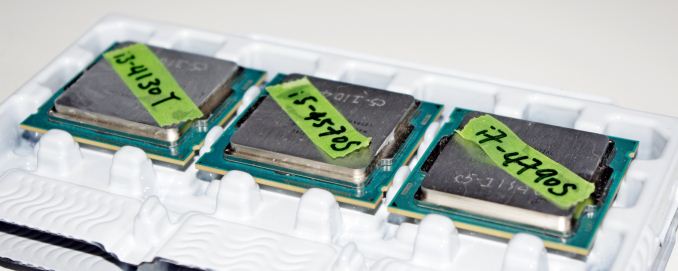Intel Haswell Low Power CPU Review: Core i3-4130T, i5-4570S and i7-4790S Tested
by Ian Cutress on December 11, 2014 10:00 AM ESTHaswell Low Power CPU Conclusion
There is a clear demand for lower powered everything, as long as the performance is still there. We saw this with the MSI B85M ECO motherboard we reviewed recently, whereby as long as it makes financial sense as well it becomes a win-win.
Intel ultimately keeps its binning and testing process secret, but it is the binning process that allows them to keep high yields by a partitioning off defective cores or CPUs that do not conform to the best voltage/frequency curves. Some CPUs will fall into multiple bins, allowing Intel to sell the unit as a model that needs a boost in stock due to consumer demand. This is why some processors can perform as well as others in terms of their voltage/frequency response, but the only way to guarantee a certain level of performance is to buy the exact processor you need.
Today we tested three processors: the i3-4130T, the i5-4570S and the i7-4790S. These tackle three competitive price points on Newegg at $135, $215 and $315. This is the main reason we requested these processors in rather than others, as many S or T models end up as OEM only. The OEM only models sometimes appear for sale depending on the retailer and their own stock levels, or the region, but are not available everywhere. This is a shame, as some real gems (like the i7-4765T) are on Intel's road map.
The S processors command nothing extra over the base cost, in comparison to the premium of the K models. In terms of performance, in single threaded benchmarks (and therefore responsiveness) these CPUs performed the same as their counterparts, and our i7-S CPU was right on the money all the way through. Particularly in our gaming benchmarks, no performance was lost against the bigger models. In mutlithreaded benchmarks, there was a slight performance decrease. This means a Google Octane result down from 33512 with the i7-4790 to 31127 with the i7-4790S, a loss of 7% in exchange for the reduction in TDP, but in our gaming benchmarks the only real deficit afforded by the S/T processors was that in a few circumstances, minimum frames were lower, such as Bioshock Infinite moving from 28.0 FPS on the i3-4360 to 24.5 FPS on the i3-4130T.
With the T processors, the cut is more severe, especially for the i7 models. For our i3 T processor, we are reducing down from a 54W base component to a 35W, similar to the i7 S reductions. As a result, the benchmark numbers, while lower, are comparable to those i3 models with a potential sticker saving of 19W.
Is the power reduction worth the increase in cost? Ultimately the main use for lower power processors is for systems where heat and noise are critical junctures in the design. By using a lower power processor, the heatsink can also be smaller. This means certain office designs and machines destined for communal areas of the home are the main target points, as well as potential servers that end up locked in a room somewhere. Intel's range of lower powered Haswell processors, according to their road maps, is quite substantial, although one downfall for end users is that some of the exciting parts are OEM only.











76 Comments
View All Comments
Wolfpup - Friday, December 12, 2014 - link
I'm actually looking at an HP all in one (for a kitchen computer) that has an S series CPU, and was wondering what the heck it was.35 watts for a dual core Haswell @ at least 2.9GHz is actually really impressive when you think about it. I still can't help but compare everything to my 125-watt single core 3.4GHz Prescott from ten years ago. That's a ton more performance crammed in to about 1/4 the power :) Also seems like the 35 watt parts are basically like the normal mobile parts are (before low end systems switched from 35 and 45 watt cpus to 15-19 watt ULV CPUs practically across the board)
samer1970 - Saturday, December 13, 2014 - link
Hello,can you please run the benchmarks again for the xeons with HT disabled? i want to see how the 65Watts 12 cores compares to the 6 cores i7 with hyperthreading disabled on the 12 cores one.
that is 12 cores xeon at 1.8 ht disabled versus 6 cores at 3.6 with ht enabled , which is lolgically 1.8 with ht but at 140w
FYoung - Saturday, December 13, 2014 - link
It would be beneficial to Anandtech and its readers to edit articles like this more closely. It has multiple instances of confusing wording and wordiness.I mean this as constructive criticism in case it escaped your attention, in the hope that Anandtech will not let its standards slip.
LoneWolf15 - Sunday, December 14, 2014 - link
For future articles like this, can you post the integrated graphics? It can be crucial to people building an HTPC.LoneWolf15 - Sunday, December 14, 2014 - link
Clarification: can you post the model of IGP (4400,4600) in your charts? This can be very useful for someone who is saving power by not having a discrete GPU but wants the best Intel offers.coder543 - Sunday, December 21, 2014 - link
I don't know why you're using Linux-Bench. Phoronix Test Suite (PTS) is *the* well-established benchmark suite for Linux, and it can test a wide range of applications and synthetic benchmarks in a completely automated fashion.